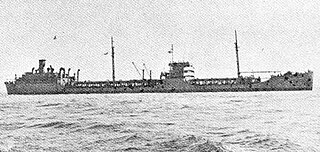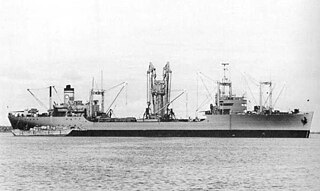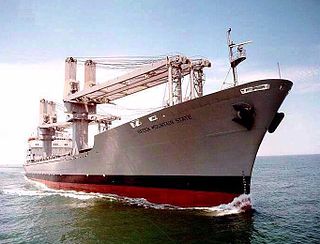
The United States Navy maintains a number of its ships as part of a reserve fleet, often called the "Mothball Fleet". While the details of the maintenance activity have changed several times, the basics are constant: keep the ships afloat and sufficiently working as to be reactivated quickly in an emergency.

Suisun Bay is a shallow tidal estuary in Northern California. It lies at the confluence of the Sacramento River and San Joaquin River, forming the entrance to the Sacramento–San Joaquin River Delta, an inverted river delta. To the west, Suisun Bay is drained by the Carquinez Strait, which connects to San Pablo Bay, a northern extension of San Francisco Bay. Grizzly Bay forms a northern extension of Suisun Bay. Suisun Bay is between Contra Costa County to the south and Solano County to the north.

The National Defense Reserve Fleet (NDRF) consists of ships of the United States, mostly merchant vessels, that have been mothballed but can be activated within 20 to 120 days to provide shipping during national military emergencies, or non-military emergencies such as commercial shipping crises.

A Naval Inactive Ship Maintenance Facility (NISMF) is a facility owned by the United States Navy as a holding facility for decommissioned naval vessels, pending determination of their final fate. All ships in these facilities are inactive, but some are still on the Naval Vessel Register (NVR), while others have been struck from the register.

The Beaumont Reserve Fleet, was established by act of Congress in 1946, as a component of the National Defense Reserve Fleet (NDRF). The fleet is located in Beaumont, Texas.

SS Mission Santa Ynez was a Type T2-SE-A2 tanker built for the United States Maritime Commission during World War II. After the war she was acquired by the United States Navy as USS Mission Santa Ynez (AO-134). Later the tanker transferred to the Military Sea Transportation Service as USNS Mission Santa Ynez (T-AO-134). A Mission Buenaventura-class oiler, she was named for Mission Santa Inés located in Solvang, California.
SS Mission Loreto was a Type T2-SE-A2 tanker built for the United States Maritime Commission during World War II. After the war she was acquired by the United States Navy as USS Mission Loreto (AO-116). Later the tanker transferred to the Military Sea Transportation Service as USNS Mission Loreto (T-AO-116). She was a Mission Buenaventura-class oiler and was named for Misión de Nuestra Señora de Loreto Conchó, located in Loreto, Baja California Sur, Mexico, considered the "Head and Mother of all the California Missions."
SS Mission San Jose was a Type T2-SE-A2 tanker built for the United States Maritime Commission during World War II. After the war she was acquired by the United States Navy as USS Mission San Jose. Later the tanker transferred to the Military Sea Transportation Service as USNS Mission San Jose. She was a Mission Buenaventura-class oiler and was named for Mission San José, located in Fremont, California.
SS Mission San Luis Rey was a Type T2-SE-A2 tanker built for the United States Maritime Commission during World War II. After the war she was acquired by the United States Navy as USS Mission San Luis Rey (AO-128). Later the tanker transferred to the Military Sea Transportation Service as USNS Mission San Luis Rey (T-AO-128). She was a Mission Buenaventura-class oiler and was named for Mission San Luis Rey de Francia, located in Oceanside, California.

Naval Station Bremerton is a former station of the United States Navy that was merged with Naval Submarine Base Bangor into Naval Base Kitsap in 2004. Kitsap serves as host command for the Navy's fleet throughout the Pacific Northwest. It is home to the Puget Sound Naval Shipyard and Intermediate Maintenance Facility. In addition to performing drydock and overhaul services for active naval vessels, it is also home to an inactive ship facility for several decommissioned warships, including aircraft carriers. Naval Hospital Bremerton is also located aboard the installation as a tenant command.

USS Soubarissen (AO-93) was an Escambia-class fleet oiler converted to a water tanker, named for a chief of the "Neutral" Indian Nations which, although a part of the Iroquois confederation, were called "neutral" by the French because they took no part in the wars of the Iroquois and Hurons. The area he governed included the oil fields of northwestern Pennsylvania and western New York. The knowledge of the oil seepages there was well known among the Indians, and it was declared neutral ground so all Indians could obtain oil for medicinal and domestic purposes without danger or interference. In 1627, Joseph de La Roche Daillon heard of the oil springs and made an expedition to visit them. He was kindly received by Chief Soubarissen, shown the oil seepages, and duly reported his observations to his superiors. These observations contributed largely to the interest in the petroleum resources of the Pennsylvania region.

USS Kern (AOG-2) was a Patapsco-class gasoline tanker acquired by the United States Navy for the dangerous task of transporting gasoline to warships in the fleet, and to remote Navy stations.

USS Chestatee (AOG-49) was a Patapsco-class gasoline tanker in service with the United States Navy from 1944 to 1946 and with the Military Sea Transportation Service from 1952 and 1956. From 1957 to 1962, she was lent to the United States Air Force. She was sold for scrap in 1975.

USS Mispillion (AO-105) was an Ashtabula-class oiler that served in the United States Navy from 1945 to 1974. She was then transferred to the Military Sealift Command to continue in non-commissioned service as United States Naval Ship USNS Mispillion (T-AO-105), in which capacity she served until 1994. Thus far, Mispillion has been the only U.S. Navy ship to bear the name.

USNS Private Leonard C. Brostrom (T-AK–255) was a cargo ship for the United States Navy that was converted into a heavy lift cargo ship in the early 1950s. She was built in 1943 for the United States Maritime Commission as SS Marine Eagle, a Type C4-S-B1 tank carrier, by Sun Shipbuilding during World War II. In 1948, she was transferred to the United States Army as USAT Private Leonard C. Brostrom after Leonard C. Brostrom, a recipient of the Medal of Honor. In 1950, the ship was transferred to the Military Sea Transport Service of the U.S. Navy as a United States Naval Ship staffed by a civilian crew. After ending her naval service, she entered the National Defense Reserve Fleet in October 1980 and was sold for scrapping in June 1982.

SS Green Mountain State (T-ACS-9) is a crane ship in ready reserve for the United States Navy. The ship was named for the state of Vermont, which is also known as the Green Mountain State.

The Suisun Bay Reserve Fleet colloquially known as the mothball fleet, is located on the northwest side of Suisun Bay in Benicia, California. The fleet is within a regulated navigation area that is about 4+1⁄2 miles long and 1⁄2 mile (0.80 km) wide. It begins just north of the Union Pacific Railroad Bridge and runs northeast, parallel to the shoreline. Water depths range from about 46 feet at Mean Lower Low Water (MLLW) at the foot of the anchorage, to about 26 feet (8 m) MLLW at the shallowest berths towards the northern end of the anchorage. As of February 2024, seven ships remain in the fleet.

The SS Alamo Victory was the 42nd Victory ship built during World War II under the Emergency Shipbuilding program. She was launched by the California Shipbuilding Company on July 13, 1944, and completed on August 18, 1944. The ship’s United States Maritime Commission designation was VC2- S- AP3, hull number 42 (V-32), she worked as merchant marine for all of her career. SS Alamo Victory served in the Pacific Ocean during World War II and was operated by the Isthmian Steamship Company. The 10,500-ton Victory ships were designed to replace the earlier Liberty Ships. Liberty ships were designed to be used just for World War II. Victory ships were designed to last longer and serve the US Navy after the war. The Victory ship differed from a Liberty ship in that they were: faster, longer and wider, taller, had a thinner stack set farther toward the superstructure, and had a long raised forecastle.

United States Naval Station Orange, later Texas Group, Atlantic Reserve Fleet and US Naval Reserve Orange was a major United States Navy shipyard in Orange, Texas on the Sabine River. The shipyard opened on August 24, 1940, to manage the construction of 24 landing craft. To support the shipyards the navy built new naval offices, barracks and civilian housing. The Navy built twelve piers in the Sabine River at the Base. U.S. Naval Station Orange also worked with the civilian shipyards in Texas during World War II. Major civilian shipyards were: Consolidated Steel Corporation, Levingston Shipbuilding Company, and Weaver Shipyards. At the end of the war in November 1945 the shipyard was closed and the base was turned into the Texas Group, Atlantic Reserve Fleet with 250 ships.

The James River Reserve Fleet (JRRF) is located on the James River in the U.S. state of Virginia at near Fort Eustis. James River Reserve Fleet, a "ghost fleet", is part of the National Defense Reserve Fleet. The Reserve Fleet ships in storage, called "mothballed", that can be ready for use if needed. Many are awaiting scrapping due to the age or condition of the ship. Some ships are used for target practice or as artificial reefs. A few ships became museum ships and other sold to private companies. Ships can be readied for use in 20 to 120 days during national emergencies or natural disaster. The U.S. Department of Transportation's Maritime Administration (MARAD) provides oversight of the James River Reserve Fleet. For the United States Navy ships the United States Navy reserve fleets stored these ships and submarines.


















